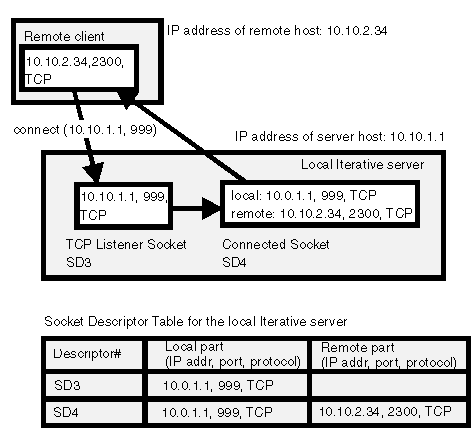 z/OS Communications Server: IP Sockets Application Programming Interface Guide and Reference
z/OS Communications Server: IP Sockets Application Programming Interface Guide and Reference
 z/OS Communications Server: IP Sockets Application Programming Interface Guide and Reference
z/OS Communications Server: IP Sockets Application Programming Interface Guide and Reference
|
Previous topic |
Next topic |
Contents |
Contact z/OS |
Library |
PDF
Accepting client connection requests in an iterative server program z/OS Communications Server: IP Sockets Application Programming Interface Guide and Reference SC27-3660-00 |
|
|
To this point in the process, the server has allocated a socket,
bound the socket to an IP address and port, and issued a passive open.
The next step is for the server to connect with a client. The accept()
call blocks the server until a connection request arrives; if there
are connection requests in the backlog queue, a connection is established
with the first client in the queue. The following example shows the
accept() call:
The accept() call dequeues the first queued connection request or blocks the caller until a connection request arrives over the IP network. The accept() call uses the variables listed in Figure 1. Figure 1. Variables used by the ACCEPT
call
This call works with the following socket descriptors:
The original socket, which was passed to the accept() call, is
unchanged and is still representing our server half association only:
When control returns to your program, the socket address structure passed on the call has been filled with the socket address information of the connecting client. Figure 2 illustrates the socket states. Figure 2. Socket states
 When a socket is created, we know the protocol that we are going to use with this socket, but nothing else. When a server calls the bind() function, a local address is assigned to the socket, but the socket still only represents a half-association; the remote address is still empty. When the client connects to the listener socket and a new socket is created, this new socket represents a fully bound socket possessing both a local address (that of the listener socket) and a remote address (that of the client socket). Figure 2 illustrates a fully bound socket. Subsequent socket calls for the exchange of data between the client and the server use the new socket descriptor. The original socket descriptor remains unused until the iterative server has finished processing the client request and closed the new socket. The iterative server then reissues the accept() call using the original socket descriptor and waits for a new connection. 


|
 Copyright IBM Corporation 1990, 2014 Copyright IBM Corporation 1990, 2014 |